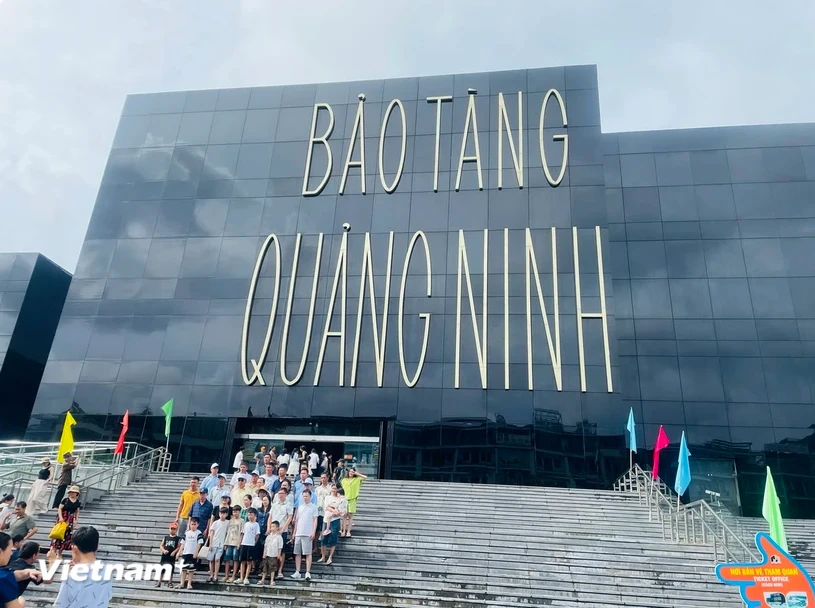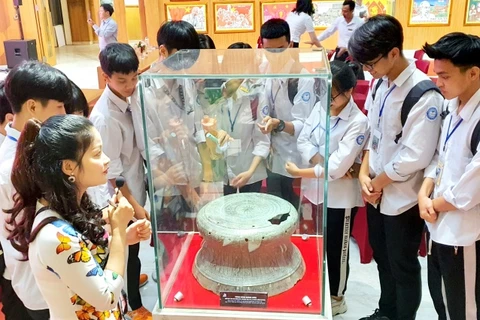
Quang Ninh (VNA) – The Quang Ninh Museum is a popular tourist attraction in the northeastern coastal province of the same name – the land of coal in Vietnam.
It looks like a giant mirror reflecting the majestic shape of the sea and sky of Ha Long Bay, a UNESCO-recognised World Natural Heritage Site.
The museum, situated along coastal Tran Quoc Nghien street, about 7 km away from Ha Long city’s centre, is also a great pride of Ha Long people as it showcases the cultural and spiritual values of the land of coal.
1. The establishment of the Quang Ninh Museum
Established on September 2, 1960, the museum was built at 5B Cau Cao, Hon Gai township, and called the Hong Quang Museum of History and Revolution.
On October 30, 1963, Hong Quang area merged with Hai Ninh province to form Quang Ninh province. The museum was renamed the Provincial Quang Ninh Museum, more commonly known as the Quang Ninh Museum.
In 1990, the People’s Committee of Quang Ninh province designated the premises of the Quang Ninh Import-Export Company at 165 Nguyen Van Cu street, Ha Long city, as the site for the Provincial Quang Ninh Museum.
In 2012, the museum’s construction started, and on October 13, 2013, the museum was inaugurated.
2. Unique architecture
The Quang Ninh Museum and Quang Ninh Library were both designed by famous Spanish architect Salvador Perez Arroyo with a unique design concept inspired by the image of coal, a typical mineral found in Quang Ninh.
The building is equipped with 14,000 sq.m of semi-tempered, shatter-resistant glass that can withstand drastic temperature changes.
The black glass brings a mysterious look to the museum and sets an image of black pearls - a precious product found in the Ha Long region.
Notably, the museum’s exterior takes on magical color changes at different times of the day and in changing weather conditions.
In addition, the eye-catching name of the museum appears on the grass wall and the zigzag staircase in front of the structure; a spot worthy of a photo opportunity.
3. Treasure trove of art, history
The Quang Ninh Museum consists of both indoor and outdoor exhibition areas.
The outdoor exhibition features large objects such as anti-aircraft guns, rocket launchers, and ancient cannons. Notably, there is an anthracite coal block weighing about 28 tonnes, mined at a depth of 176m. It is recognised as the largest monolithic anthracite coal block in Vietnam.

Inside the museum, the first floor is designated for the displays of biodiversity and nature. It is divided into four themes that include geology, sea, insects, and flora and fauna.
Visitors can see the skeletons of giant whales and sharks. They can also get information about the ocean and the history of evolution under the sea.
The 2nd floor is a historical exhibition area that is designed like a giant boat with archaeological artifacts dating from prehistoric times to the Dai Viet period. These artifacts carry great historical and cultural values, affirming that Ha Long culture has a history of thousands of years.
The exhibition area of revolutionary resistance artifacts is not large but is full of the artifacts associated with the army and people of Quang Ninh province during the resistance war against the French colonials and the US imperialists.

In addition, visitors can find a model of Dong Pagoda, and artifacts about Truc Lam Zen sect and Tran Dynasty heritage in Dong Trieu, which reveal a brilliant development period of culture-architecture-art of the Tran Dynasty.
There is an antique room where antiques are collected in the province and from other countries like China and Japan. Those antiques affirm the unique culture and trade of Quang Ninh, home to the famous Van Don trading port.
Meanwhile, the 3rd floor recreates the history of the coal industry – an iconic symbol of the province.
The coal mine models with identical sizes and statues depict the hard work that miners endured.

In addition, cultural features of minority ethnic groups in the province are also introduced at the museum.
A thematic exhibition showcases the activities of President Ho Chi Minh in the province and memories between the national leader and the people of Quang Ninh ethnic groups.
The Quang Ninh Museum is a new tourism product with great educational significance for the young generation. It is highly recommended to visitors when coming to Quang Ninh./.






















